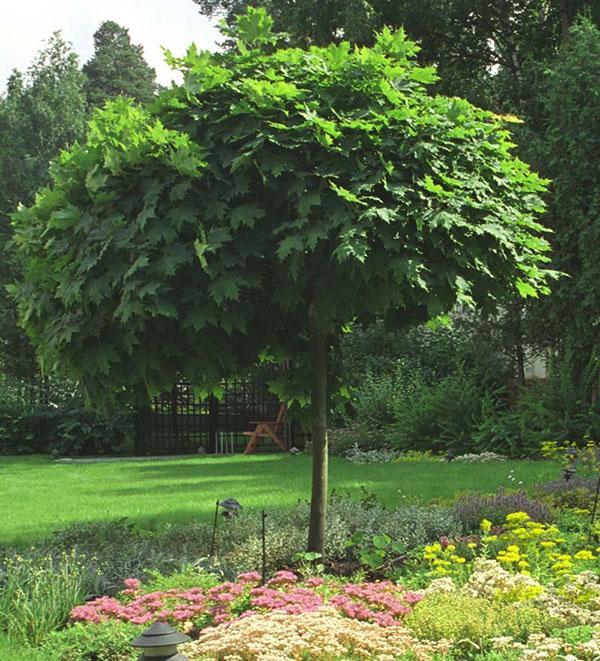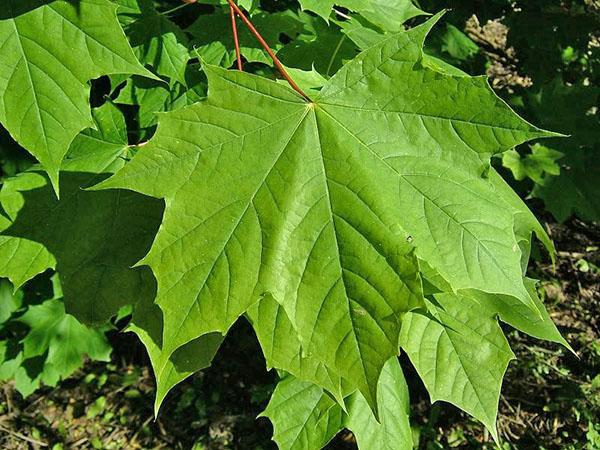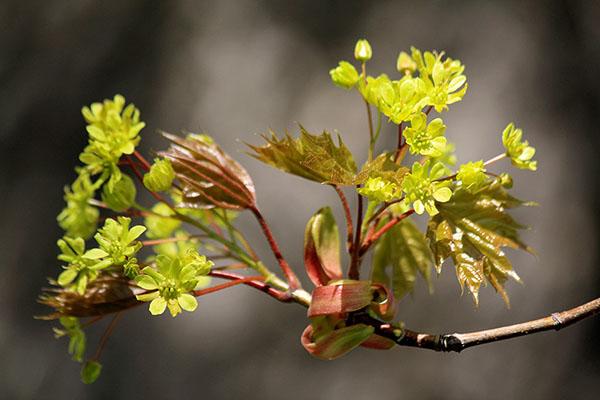Grow a wonderful Norway maple tree, planting and caring for it is easy
 Maples are one of the most noticeable and beautiful trees in central Russia. Norway maple, planting and caring for which will not be difficult even for a beginner, can decorate not only the forest edge, but also a suburban area.
Maples are one of the most noticeable and beautiful trees in central Russia. Norway maple, planting and caring for which will not be difficult even for a beginner, can decorate not only the forest edge, but also a suburban area.
Description of the Norway maple

 But the tree is no less vivid in the second half of spring, when its branches cover corymbose inflorescences of 15-30 fragrant yellow-green flowers. They open until the maple leaves bloom. On sunny days, a quiet hum of attracted flowers emanates from the crown bees and other insects.
But the tree is no less vivid in the second half of spring, when its branches cover corymbose inflorescences of 15-30 fragrant yellow-green flowers. They open until the maple leaves bloom. On sunny days, a quiet hum of attracted flowers emanates from the crown bees and other insects.
The tree is an excellent honey plant, thanks to the shade formed by the foliage, it can cover an open area from the scorching sun and cold winds.
It is not surprising that the question: "How to transplant a maple from the forest to a plot or grow a seedling on your own?" interests of many summer residents.
But before deciding to plant, it is important to know that an adult tree reaches 30 meters in height and requires significant free space. The shallow root system of maple, blocking access to nutrients and water, interferes with the growth of surrounding crops.
Planting the Norway maple

If the summer resident has seedlings with an open root system at the disposal of the summer resident, the trees of the holly maple are planted in the ground:
- in early spring, when the ground thaws, and the trees have not yet begun to grow;
- in the fall, before the onset of stable cold weather.
Plants with ZKS can be planted during the entire warm period. Since the roots are not damaged, planting and caring for the Norway maple will not be a hassle even for a novice gardener.
For a seedling, choose a well-lit place, at least 2.5-3 meters away from other perennial plants. A tree needs a fertile soil permeable to moisture and air. Before planting, it is useful to add sand, peat, rotted organic matter to black soil or clay soil.
Add to poor soil in equal parts:
- garden land;
- humus;
- bottom peat;
- 120-150 grams of complex fertilizer.
 So that the maple root system does not suffer from stagnant melt and groundwater, a 15-centimeter drainage layer of expanded clay, broken brick or crushed stone is poured onto the bottom of a wide planting pit.
So that the maple root system does not suffer from stagnant melt and groundwater, a 15-centimeter drainage layer of expanded clay, broken brick or crushed stone is poured onto the bottom of a wide planting pit.
If the roots of the tree are open, they should be placed in water for several hours before planting. The seedling in the container is watered abundantly so that the entire earthen ball is soaked.
The prepared plant is placed in a hole next to a previously fixed support so that the root collar is slightly above the soil level. The planting hole is covered with prepared soil, the earth is tamped and watered. The trunk circle is generously mulched with dry soil, peat or other suitable material that prevents the soil from drying out.
Holly Maple Care
 According to the description, the Norway maple is an unpretentious frost-hardy tree that does not need laborious and continuous maintenance. And yet, care for plants, especially young ones, is needed.
According to the description, the Norway maple is an unpretentious frost-hardy tree that does not need laborious and continuous maintenance. And yet, care for plants, especially young ones, is needed.
In spring and autumn, if the weather is dry, the trees are watered once a month. On hot summer days, when broadleaf culture evaporates a lot of moisture and suffers from its loss, watering is carried out at least 1 time per week, at the rate of 2 buckets per tree.
Before the onset of winter, the young maple is watered abundantly, the trunk is wrapped with covering material or burlap, and tightly tied. This will help the plant to endure the cold, protect it from rodents and sunburn.
In addition, the trunk circle under the tree is loosened and cleaned of weeds. From the second year of life, the plants are fed twice, introducing humus or complex fertilizers with prolonged action into the loosened soil.
A special formative pruning is not necessary for the Norway maple. If in the spring some of the branches have suffered, or there are broken branches, they are cut to live wood, and the hemp is treated with garden pitch.
How maple spreads
 In nature, Norway maple is easily propagated by seeds and root shoots. Young plants appear in abundance around the stumps of old maples. The wind-blown seeds sprout into dense undergrowth.
In nature, Norway maple is easily propagated by seeds and root shoots. Young plants appear in abundance around the stumps of old maples. The wind-blown seeds sprout into dense undergrowth.
If you wish, it is not difficult to propagate the plant yourself. To harden the seeds, they are buried in the ground in the fall. Seedlings with several leaves dive in the spring. Further care before planting the Norway maple in a permanent place consists in regular watering, weed control and protection of the seedlings from the cold.
You can bring a seedling from the forest. In this case, it is important:
- choose a strong 1-3 year old plant without signs of disease or damage to the trunk;
- if possible, keep an earthen lump that hides the roots;
- before planting, treat the roots, trunk and crown with a solution of fungicides and insecticides so as not to introduce pathogenic fungi and pests on the site.
 With the advent of original decorative varieties, the gardener was interested in how maple with variegated and antacyan foliage spreads? Such plants reproduce vegetatively using air or root layers.
With the advent of original decorative varieties, the gardener was interested in how maple with variegated and antacyan foliage spreads? Such plants reproduce vegetatively using air or root layers.
Maple pests and diseases
 The trees planted on the site are exposed to pest attacks and the risk of various diseases. The enemies of maple are whiteflies, mealybugs and some types of leaf rollers. To defeat insects, insecticide treatments are used throughout the growing season. Be sure to collect and destroy the foliage fallen in autumn.
The trees planted on the site are exposed to pest attacks and the risk of various diseases. The enemies of maple are whiteflies, mealybugs and some types of leaf rollers. To defeat insects, insecticide treatments are used throughout the growing season. Be sure to collect and destroy the foliage fallen in autumn.
Pathogenic fungi are of great danger. They cause:
- various types of spotting;
- necrosis,
- deformation;
- rot;
- verticillary desiccation or wilt;
- powdery mildew.
 A manifestation of Norway maple disease, as in the photo, is extraneous spots on the leaves, deformations and wilting of shoots, "witch's brooms". Sometimes the color of the wood changes, the leaves dry for no apparent reason.
A manifestation of Norway maple disease, as in the photo, is extraneous spots on the leaves, deformations and wilting of shoots, "witch's brooms". Sometimes the color of the wood changes, the leaves dry for no apparent reason.
The affected parts of the plants are cut out, the foliage is collected and destroyed. Maple is treated with fungicides in 2-3 doses. The exception is wilt. Infected trees are dug up by the roots and burned, since pathogens remaining in the soil infect not only maples, but also potatoes, sunflower, beets, other crops.